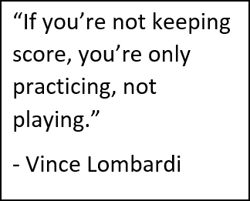
“Why can’t we even get this data out of our systems? I want to start measuring this, now! Why isn’t this information at my fingertips?” If these questions or comments sound familiar, you’re not alone. Data, metrics and reporting create some of the most vexing challenges in talent management. People often don’t agree on what to measure or have the systems in place to measure it — or they simply don’t know what to do about the data they do track. How do you solve this? Do you need more technology? Do you need more data?
Actually, the answer may be more basic. It’s not about technology; it’s about mindset. Understanding the human lessons in measuring performance can go a long way to taking control of the processes and technologies that improve talent management impact. So, when you’re asking questions about talent management data, here’s a good way to start: think like a runner.
I started running about four years ago. I was terrible. But as both a runner and a data nerd, I immediately started looking into the technical options to help me improve, and I discovered a wealth of choices. Now I have training plans loaded on my running-specific watch, apps for my phone, a heartrate monitor and pedometers. I know how much I should be running, how many steps I take, my heartrate throughout the run, my pace per mile, my pace relative to change in altitude, all the way to how many miles I have on specific pairs of shoes. You get the idea.
| A runner’s perspective can help reveal what you may unintentionally be asking or expressing when you react to your talent management performance data (or lack thereof). Knowing this, you may be able to adjust your questions, more quickly reach practical results, and improve performance across your talent management functions. Here are a few of the most common issues standing in the way of an effective performance measurement strategy. |  |
1. Conflicting Goals
A company may track and base talent management performance on the metric of time-to-fill, but then suddenly realizes it has issues with quality of talent. Out of the blue, a talent decision maker might receive pushback from executives about high turnover in challenging roles. That decision maker asks why he or she can’t track improvement in quality of hire? The answer: you can’t measure a marathon by the standards of a sprint.
If a talent management organization emphasizes challenging time to fill goals, quality of hire may suffer, just as a sprinter may succeed on short distance times but would eventually fall short in the long distance. How do you reconcile the two? For the talent management team, performance measurement begins by understanding the desired outcomes. The goal drives the measure. If you’re not collecting quality metrics and depending on speed metrics to determine performance, there will be little or no impact on your desired outcome of high quality talent.
2. Changing Directions
No one would start a race, run toward the finish line and suddenly decide to turn left and run to some different finish line halfway through the effort. It may sound too silly to even think about, but that’s exactly the unintended consequence of the frequent and understandable, “I want to start measuring this now” reaction when someone discovers a new talent management issue.
If, for example, you suddenly realize that you have an employee retention issue in a particular department or role, and then think you can track the factors and fix the issue with some immediate configuration of current technology, think again. Identifying goals, determining the data that contributes to those goals, collecting and analyzing that data and pinpointing issues is not an immediate fix. In fact, even if you could make the connections instantly, the value of data is only significant if that information is collected over time. Only with an investment in data collected over time can you determine normal values versus anomalies, or positive versus negative trends. If you need to run a different race, start at the beginning.
3. Management by Pain
There is a root cause to the previous two issues, and it truly applies to both running and talent management: many requests are driven not by goal attainment, but instead by problem avoidance. In other words, we want to track our ability to diminish or avoid the problems before us. This creates obvious difficulties in running, since a runner would do well to stop or slow his or her progress at the first sign of hardship. The result: a race unfinished. In talent management, this can happen when an executive sponsor asks for data to show why there is a problem in some area and reveal how that problem can be fixed.
Talent management data, however, is best aligned to a positive goal. This requires an understanding of what could and should be achieved, whether in terms of talent quality, cost, speed or business agility. Understanding the outcome, you can set a more practical and easily measured path toward a specific improvement goal. This sets the stage for longer term measurement strategy which will then yield lasting and tangible results.
Putting it all Together: Goal-driven Talent Management Metrics
While there is no hard and fast rule for how to start the measurement and performance discussion, there are a few good questions that can help get us started. First, can we say that we know where we are? Where we are going? Where we are having problems? How to get better? My guess is that most organizations will say no to one or more (or all) of these questions.
What do we need to do to get there? For running, I set my goals. How fast do I want to run? How far do I want to go? How long do I want to run? How many miles can I put on my shoes before I need a new pair? After four years of work, I have actually become reasonably competitive; I finished a 7-mile race with relative ease and I know where I struggled and how I can get better for next year. Do you know enough to know how your talent management organization has improved and determine what the organization needs to do to be better next year -- to make the right moves to continue to grow?
Talent management organizations need to know what’s important so the data they gather can be used to assess the organization, make adjustments and continue to get better. Once we figure out the desired outcomes and the data we need to make decisions, we have to ensure that we have the desired data in place, and then determine a method to deliver the information to the right people at the right time.
Runners and talent management organizations can both use the data they have to improve performance. Success is not just about the stopwatch (or metrics and a reporting function); it’s about patience and focus—qualities that will never be replaced by technology.


